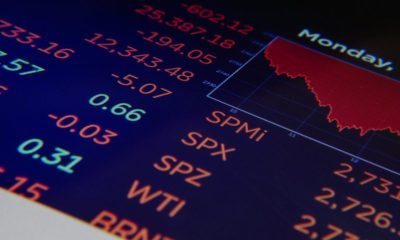Featured
Global economies are headed toward a synchronized decline—here’s why
With a cyclic inflation-deflation behavior seen at the stock market, investors are expecting further increases in global debt tantamount to $237 trillion.

Not too long ago, the overwhelming consensus from the perennial Wall Street Carnival Barkers was that investors were enjoying a global growth renaissance that would last for as far as the eye can see. Unfortunately, it didn’t take much time to debunk that fairy tale. After a lackluster start to 2018, the market’s expectations for global growth for the remainder of this year is now waning with each tick higher in bond yields.
The U.S. economic growth displayed its usual sub-par performance in the first quarter of 2018; with real GDP expanding at a 2.3 percent annual rate, which was led by a sharp slowdown in consumer spending. The JPMorgan Global PMI™, compiled by IHS Markit, fell for the first time in six months, down rather sharply from 54.8 in February to a 16-month low of 53.3 in March. The index point drop was the steepest for the past two years.
To put that decline in context, the February PMI reading was consistent with global GDP rising at an annual rate of 3.0 percent. However, the March reading is indicative of just 2.5 percent annualized growth. Therefore, not only is global growth already in the process of slowing, but the insidious bursting of the bond bubble is gaining momentum and should soon push the economy into a worldwide synchronized recession.
One thing that was on the rise in the first quarter of the year was inflation expectations. Consumer inflation increased at a three-month annual rate of 2 percent, as wage growth increased by nearly 3 percent. The increase in wage growth is most likely sounding alarm bells for the members of the FOMC, who are of the belief that gainfully employed people are the very progenitors of runaway inflation.
This spurious reasoning will give more credence to the fatuous Phillips Curve Model of inflation—of which all members of the Fed worship under—and thus cause them to hike rates to 2.0 percent at the June meeting. And also to signal that there are many more rate hikes ahead.
Nevertheless, before the economy reaches its inevitable bout with intractable inflation, it will experience a deflationary depression cycle brought on by the unprecedented governmental experiment of raising rates at the same time it is also destroying $30 billion per month worth of its money. This phenomenon will soon increase to $50 come October—just as annual deficits leap well above $1 trillion.
The attempt of central banks to exit interest rate repression, along with a massively increased debt load, has dramatically stretched the skin on the international bond bubble so thin that air has started to pour out. And as interest rates are rising, global economies are coping with debt loads so massive they have even drawn the concern of the International Monetary Fund (IMF.)

According to the IMF, the current global debt is due to unfunded tax cuts in the United States and new debt surges in China since 2007. (Source)
The IMF calculates global debt hit $164 trillion at the end of 2016, which would be 225 percent of the size of the $73 trillion global economy; surpassing the prior peak in global debt of 213 percent of the worldwide economy in 2009. The IMF attributes this rise in global debt to unfunded tax cuts in the United States and the surge of new debt in China since 2007.
In fact, China alone contributed 43 percent to the increase in debt since 2007. China’s debt surged from $1.7 trillion in 2001 to $25.5 trillion in 2016. The IMF describes China as the “driving force” behind the increase in global debts, with three-quarters of the rise in private sector debt during the past decade.
China was once the growth engine for the global economy, but due to its teetering debt pile is now forcing headwinds upon global GDP. Perhaps this is why the Shanghai Composite Index is down 14 percent from its January 26th high.
But the Institute of International Finance has also calculated the debt burden, and the data here is even more daunting. They have the debt of worldwide economies pegged at $237 trillion as of September 30, 2017. If you do the math, $237 trillion in global debt will put global debt-to-GDP at a whopping 318 percent!
It should be mentioned that the global GDP ratio figure is completely phony, as the denominator is artificially boosted by trillions of dollars’ worth of negative nominal interest rates and will collapse under that overhanging debt pile as rates normalize.
It is clear that massive global government debt impedes growth. But these enormous debt loads aren’t limited to the sovereign level. Corporations are also carrying untenable debt loads. During the 2008 financial crisis, Warren Buffet famously noted that when the tide comes out, we can see who is swimming naked. And today those skinny dippers are Zombie companies that are barely keeping their heads above water by refinancing debt at ultra-low rates.
Zombie companies are those whose interest expense is higher than their 3-year average EBIT (earnings before interest and taxes). And there is no doubt as to what engendered these “Walking Dead” firms…the global bond bubble. The Bank of International Settlements and the OECD estimate that 10 percent of firms in the entire Western World exists solely as Ponzi Schemes. And according to data from Glenmede, Zombie Companies account for 16 percent of the components of the Russell 3000, which is nearly double the 8 percent ratio at the start of the financial crisis.
What is most frightening here is this dangerously high number exists in the context of record-low borrowing costs. Meaning, the bond bubble collapse will bring rapid and complete devastation to these companies just as the total number of firms dragged into this category soars.
These companies will not survive the continuation of this bond market collapse and its subsequent depression. Furthermore, how will over-indebted governments survive the next economic downturn? The answer here is through a permanent debt monetization on a global and unprecedented scale.
Investors should already have a plan in place to profit from deflation and inflation cycles such as never before witnessed in history.
—
DISCLAIMER: This article expresses my own ideas and opinions. Any information I have shared are from sources that I believe to be reliable and accurate. I did not receive any financial compensation in writing this post, nor do I own any shares in any company I’ve mentioned. I encourage any reader to do their own diligent research first before making any investment decisions.

-

 Impact Investing1 week ago
Impact Investing1 week agoEU Expands Leadership in Sustainable Finance with Record Green Bond Impact
-

 Impact Investing5 days ago
Impact Investing5 days agoEU End-of-Life Vehicles Rule Pushes Cars Toward a Circular Economy
-

 Crowdfunding2 weeks ago
Crowdfunding2 weeks agoFlower Burger Launches Crowdfunding to Fuel Growth in Booming Plant-Based Market
-

 Business3 days ago
Business3 days agoTopRanked.io Weekly Affiliate Digest: What’s Hot in Affiliate Marketing [1xBet + FIFA World Cup]

























You must be logged in to post a comment Login